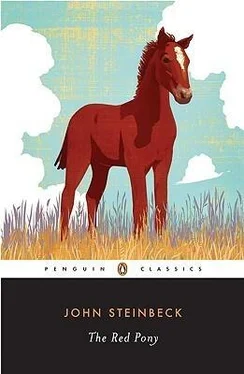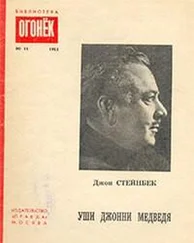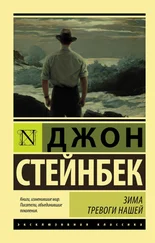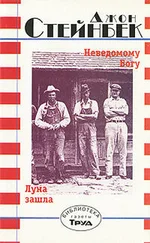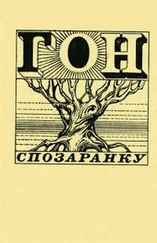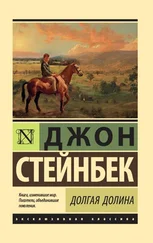Such a return helps to remove the literary and critical veils of contextuality and conventional expectation that have been placed between us and Steinbeck’s Red Pony stories—accretions, ironically enough, that include the novels of Rawlings and O’Hara. Indeed, even the title of the book is a red herring of sorts that lines a trail toward The Yearling and My Friend Flicka . The title, which is taken from the first story in the cycle, falsely implies that the rest of the stories have a common connection with Jody’s “gift” of a colt, when, as we have already seen, Steinbeck seems to have thought of them as a cycle centering on the Tiflin family—including the farmhand, Billy Buck. Moreover, the horses that do figure in the stories are innocent, even passive participants in a kind of ongoing family politics, especially the power play between the father and son. Family politics most certainly figure in the novels by Rawlings and O’Hara, but these result, finally, in resolutions intimate with the presence and function of pets. By contrast, in Steinbeck’s parables, the several horses do not resolve but point up familial discontents, and their use, finally, is discontinuous. What, we might ask, happens to the colt born in the third story, the one whose birth is so terribly costly and who is intended to replace Gabilan, the titular red pony? No mention is made of that presumably important animal in the final story, and if “A Leader of the People” is summary, as it has been read, then the colt named Black Satan should somehow be part of the tale, much as Gabilan’s death overshadows the story of the second colt’s birth. Instead, the last story acts to turn events back on themselves, not move them forward to some kind of cumulative conclusion. We might even assume that the events occurred before the first colt arrived on the farm.
The first story, likewise, “The Gift,” has an element of self-deconstructiveness, starting with its ironic title. The red pony colt is the kind of “gift” called “Greek,” in that it comes hearing special conditions. Jody must earn his “gift” by attending to its training. Like many middle-class parents (as in Flicka ), Carl Tiflin hopes to use the experience as a step in an enforced process of teaching “responsibility.” But it is Billy Buck who serves as the tutor when it comes to actually caring for the pony, and his tragic failure in that regard results in the emotional explosion with which the story ends—not only Jody’s grief but Billy Buck’s turning on the unseeing father, a multiple instance of unresolved anger. The title of the third story (the last in the original cycle), “The Promise,” is again ironic. The terms of the second “gift” are such that Jody can take no pleasure in it, having required the death of Nellie, the gentle old mare: “He tried to be glad because of the colt, but the bloody face, and the haunted, tired eyes of Billy Buck hung in the air ahead of him.” Here again it is Billy Buck who is the parental figure, carrying the guilt over his omissions that caused the death of the red pony into the bloody horror of delivering the second colt. Though the death of the mare is inevitable, the position of the colt in her womb being beyond human intervention, Billy turns it into an act of retaliation against Jody: “There’s your colt, the way I promised,” he says implying that the death of the mare was somehow the boy’s fault, much as the name of the colt (given before it is born), Black Demon, carries with it a kind of foreboding or tragic necessity, linking it to the dark range of mountains much as the red pony was named for the Gabilans.
Symbols of death and loss loom over these stories, but they do not point toward any cumulative pattern of resolution. The most explicit of the parables in this regard is the second, which, like the fourth and last, exists outside the “pony” sequence. The sight of the old Mexican riding an ancient horse off into “The Great Mountains” never to return is a powerful, even archetypal image, which fills Jody with “a nameless sorrow” but no real understanding of what he has witnessed. Death may be the dominant theme of these stories, but although we can read the signs and signals, Jody cannot, and he serves chiefly as a kind of symbol himself, of boyish innocence against which the cycles of birth and death are played. Again, the cumulative result is not progressive but promotes a kind of stasis, a symbolic map of contraries and correspondences: the two ranges of mountains, the two colts, the two old men, the two “fathers,” an arrangement centered by the “round tub at the brush line” and the sad boy lying next to it “with his crossed arms and… nameless sorrow.”
Like many innocents in American fiction, Jody is something of a Christ figure, burdened with sorrows occasioned by other men. But in many telling ways, also, he is not a particularly sympathetic little boy—again in contrast to the youths in Yearling and Flicka . He is given to bullying Doubletree Mutt, the family dog, and pestering the cat in Tom Sawyer fashion—but without Tom’s saving grace of mischievous humor. He revenges himself upon his nagging parents by killing a songbird against their specific proscriptions, and we can hardly be sympathetic toward his cold-blooded plans to kill a community of unsuspecting mice—whose chief crime seems to be their plumpness. Christ does not come to mind but rather Twain’s Young Satan. This is clearly not Wordsworth’s or even Rousseau’s Natural Child but rather a kid by way of Calvin and Hobbes. Again, all of these gestures are integral to the power play that makes up the chief substance of the stories, ending with Jody’s bearing a glass of lemonade to his grandfather, a tart sacrament of rebellion against his father. “He didn’t care about the bird, or its life, but he knew what older people would say if they had seen him kill it; he was ashamed because of their potential opinion.”
The Red Pony is undoubtedly the most unconventional story about the adventures of a boy in rural America that can be found in our national canon, lacking as it does both a developmental sequence and a strong moral overlay of didacticism. I have been told that it has become a particular favorite among younger readers—teenagers, not children—perhaps for the same reasons I was drawn to Steinbeck’s fiction during my own high-school years. Adolescents are attracted to stories that seem to present a realistic account of life—including death—nor are they made particularly uncomfortable by scenes of cruel, even unwarranted suffering. Neither Catcher in the Rye nor Lord of the Flies were taken up by young readers because of any positive moral at the end, and recent examples of fiction specifically written for adolescents likewise approach the balance of situational ethics, not the loaded situations of proscriptive, adult-legislated morality.
If I have drawn extended comparisons between The RedPony and equivalent stories by Marjorie Kinnan Rawlings and Mary O’Hara, it was not merely to emphasize differences. Both of these subsequent, very popular novels bear clear debts to Steinbeck, despite their contrasting emphases, and though more clearly written for adolescent readers, they also avoid the easy resolutions and faultless adult tutors of so much earlier literature aimed at that young audience. True, problems are introduced in those two novels in order to achieve resolutions, and the deaths and near deaths of pets are integrated to the social necessity of maturation. But both stories share Steinbeck’s interest in psychological and familial realism, presenting parents and other adults who can be as misguided and self-interested as children. And both portray the rural scene as something less than the locus of a pastoral idyll, but rather as a place in the American landscape as prone to economic complications and deadly accident as the urban scene. These emphases, I would suggest, can be traced to Steinbeck’s influence.
Читать дальше
